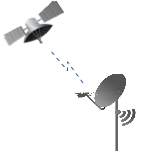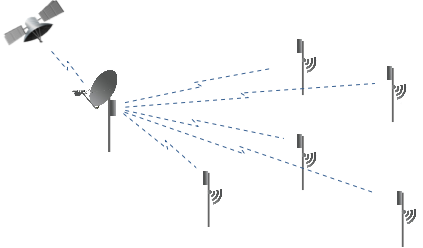Difference between revisions of "BasicInternet:Satellite provision"
From its-wiki.no
Josef.Noll (Talk | contribs) (→Satellite provision) |
Josef.Noll (Talk | contribs) (→Si5 configuration) |
||
| Line 23: | Line 23: | ||
* a wifi unit, transmitting the 2.4 GHz, e.g. xxx | * a wifi unit, transmitting the 2.4 GHz, e.g. xxx | ||
| + | In the S<sub>i5</sub> configuration we need to ensure free sight (no obstacles, no trees) between the main distribution antenna and the antennas at the customer site. This might require mounting the 5 GHz distribution networks on poles. | ||
| + | Typical maximum ranges are 5-8 km for each of the distribution links. | ||
== S<sub>i20</sub> configuration == | == S<sub>i20</sub> configuration == | ||
same as S<sub>i20</sub>, but with 4 x 90 deg antennas for distribution to a total of 20 or more customer receive stations covering the whole area. | same as S<sub>i20</sub>, but with 4 x 90 deg antennas for distribution to a total of 20 or more customer receive stations covering the whole area. | ||
Revision as of 20:38, 9 November 2014
| Satellite provision | |||||||
|---|---|---|---|---|---|---|---|
|
Satellite provision
We have two basic forms for distribution of the Basic Internet
- i) Satellite Modem includes Router Board
- e) Satellite Modem has an exteral Router Board
The Router Boards are preconfigured with an IP address, and thus only need to be connected to the satellite to be connected automatically to the billing centre at Kjeller.
Si5 configuration
The Si1 configuration includes
- a satellite dish (1.2 or 1.8 m diameter)
- a satellite modem including the router board, e.g. xxx
- a wifi unit, transmitting the 2.4 GHz, e.g. xxx
The receive antenna can typically be set up on the ground, at a wall or whatever other place is suitable.
Si5 configuration
The Si5 configuration includes
- a satellite dish
- a satellite modem including the router board, e.g. xxx
- a distribution network, consisting of directional links from a main antenna to smaller antennas at the customer site. The link is typically operating at 5 GHz, e.g. xxx
- a wifi unit, transmitting the 2.4 GHz, e.g. xxx
In the Si5 configuration we need to ensure free sight (no obstacles, no trees) between the main distribution antenna and the antennas at the customer site. This might require mounting the 5 GHz distribution networks on poles. Typical maximum ranges are 5-8 km for each of the distribution links.
Si20 configuration
same as Si20, but with 4 x 90 deg antennas for distribution to a total of 20 or more customer receive stations covering the whole area.


